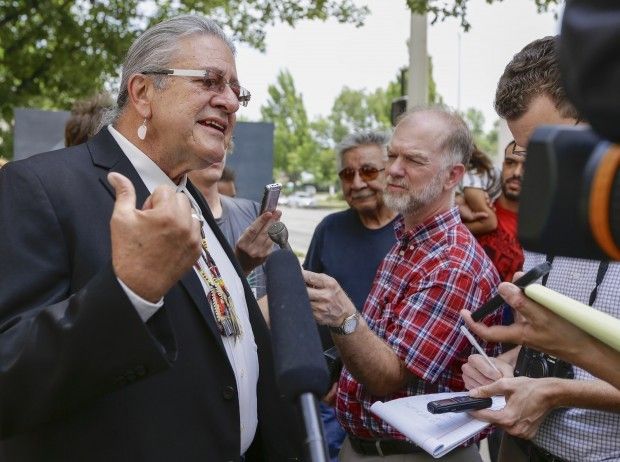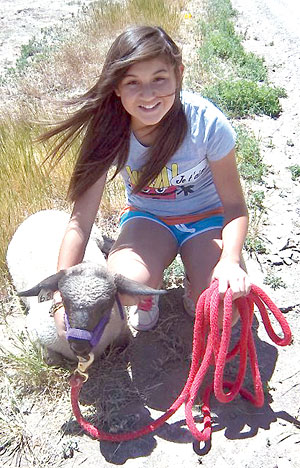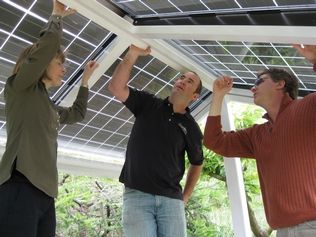By KEVIN ABOUREZK / Lincoln Journal Star
July 8th 2013
Not many problems can be solved in two minutes.
And that includes the situation in Whiteclay.
Oglala Sioux Tribe President Bryan Brewer of South Dakota and Nebraska Gov. Dave Heineman had planned for weeks to get together Monday morning to try to address alcohol sales in Whiteclay and alcoholism on the nearby Pine Ridge Indian Reservation in South Dakota.
But the meeting ended after fewer than three minutes, and the governor’s office and Brewer later traded barbs over whose fault that was.
“I feel very bad that I came down here to talk with him for a couple minutes,” Brewer said. “He didn’t want to talk to me.”
The tribal leader said he walked out because Heineman was aggressive and said Brewer violated the governor’s request to meet without media involvement. He said the governor had asked him

NATI HARNIK/The Associated Press
to not speak to the media before their meeting.
However, both Brewer and Heineman spoke to reporters in the days and hours leading up to their meeting. Heineman spokeswoman Jen Rae Wang said Brewer was the one who originally had requested a closed meeting with no media present.
“The governor was happy to accommodate that,” she said.
Brewer said the governor was especially angry about a news release that appeared Sunday saying the governor had received $96,000 in contributions from the liquor industry and charged that illegal alcohol activity and bootlegging in Whiteclay have not been stopped because of financial contributions to him and other Nebraska politicians from Anheuser-Busch, distributors and alcohol trade associations.
A spokesman for Alcohol Justice — a California-based, self-described watchdog of the liquor industry — cited the National Institute on Money in State Politics as its source. The institute describes itself as a nonpartisan nonprofit that seeks to reveal the influence of campaign money on politicians.
“He verbally attacked me,” Brewer said. “I didn’t write that article. I don’t know why he’s mad at me.”
Wang said the governor has not been influenced by any campaign contributions from liquor industry representatives.
“That’s absolutely false, and it’s completely inappropriate,” she said.
She said the governor had set aside an hour to spend with Brewer and had invited Lt. Gov. Lavon Heidemann, Nebraska State Patrol Superintendent Col. David Sankey, Chief of Staff Larry Bare and the governor’s policy adviser to attend.
Wang said Brewer made it clear he didn’t plan to stay long and have a serious conversation about the problem of alcoholism on the Pine Ridge Indian Reservation.
At a news conference Monday morning before the meeting, Heineman said the state of Nebraska has no legal way to shut down beer stores in Whiteclay as long as those stores follow the law. And, he said, it is Brewer’s responsibility to address the underlying problem that has led to rampant alcohol sales there.
“As the leader of his tribe, he’s got to put a focus on treatment and education relative to alcohol abuse,” Heineman said.
Brewer refused to take responsibility for his people’s actions, Wang said.
“The governor remained at the table and was hopeful to have an open and honest conversation about some of the difficulties surrounding this issue,” Wang said. “I would just call it an unfortunate situation.”
The Oglala Sioux Tribal Council voted last month to hold a reservation-wide referendum this fall on whether to legalize alcohol on the Pine Ridge. Asked whether he supports that, Heineman declined to offer an opinion.
“I think that’s up to them to decide,” he said.
Brewer said he doesn’t want to see his tribe legalize alcohol but that he would do his best to regulate alcohol sales if tribal members vote yes.
He said he met earlier Monday with Omaha Sen. Ernie Chambers, who offered to assist the Oglala Sioux Tribe address alcohol sales in Whiteclay.
Brewer said he had hoped to talk to Heineman about re-creating an alcohol-free buffer zone south of the reservation that existed for more than 20 years until 1904. He said he also hoped to discuss making Whiteclay a national historic place to honor a massive sun dance that occurred there decades ago. Such a designation could force the beer stores to close, he said.
“I will continue working with the state of Nebraska,” he said. “I’ll refuse to deal with (Heineman) in the future.”
Brewer said he would like to be able to offer more treatment services to tribal members, but the tribe lacks the funding to do so. It has one treatment center with only seven beds, he said.
“I have to come up with the money somehow,” he said. “Our people are dying up there.”
During a news conference outside the State Office Building by activists after the meeting between Heineman and Brewer, Winnebago activist Frank LaMere said the governor clearly failed to show Brewer the respect he deserved as the leader of a sovereign nation.
“President, I apologize for our Nebraska governor,” he said. “I apologize for the way you were treated today.
“That to me is shameful.”
Reach Kevin Abourezk at 402-473-7225 or kabourezk@journalstar.com.
















